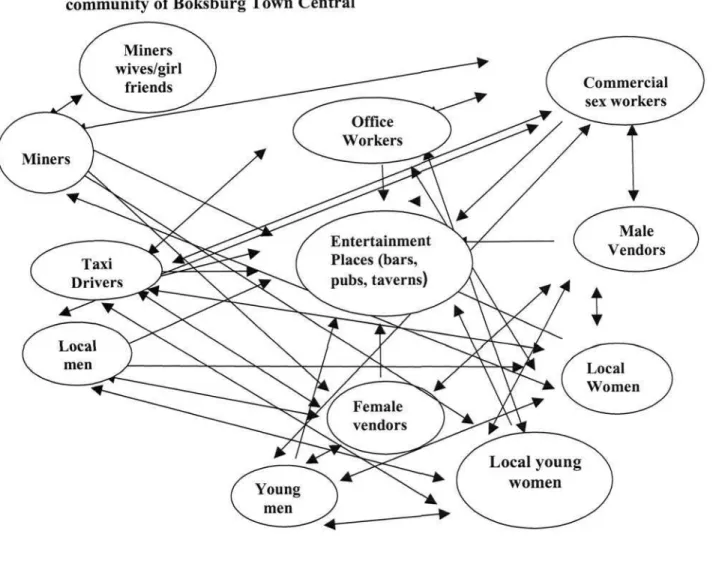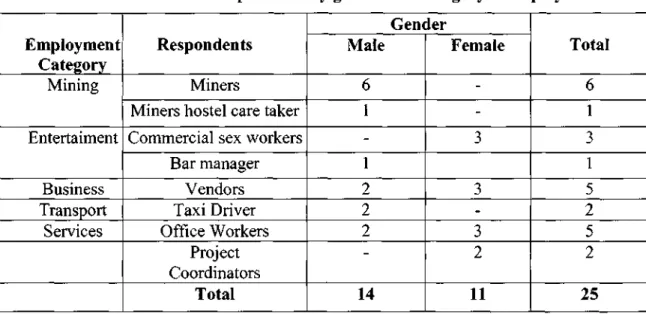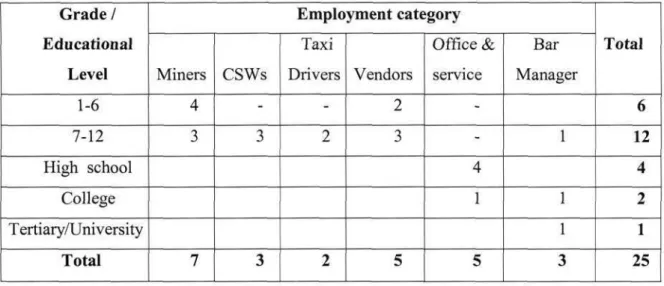The team further argues that these factors influenced not only people's sexual behavior, but also how they responded to behavior change or HIV/AIDS prevention activities they were exposed to. The aim is to investigate sexual behaviors that are believed to expose such groups of people to the risk of HIV/AIDS and STD infections, and to further investigate how such groups of people respond to behavior change and HIV/AIDS prevention activities to which they are engaged. exposed.
Research problem and objectives
Like any community with heterogeneous groups of people, residents of Boksburg communities interact with each other in many different ways (besides economic interests), some of which foster unsafe sexual behavior that can increase STI/HIV transmission in the area. Essentially, because Boksburg attracts a wide variety of people to its wealth, their diverse backgrounds and interactions provide the necessary conditions for risky sexual behavior, which could lead to increased STIHIV infections in the area.
Significance of the Study
How should HIV/AIDS prevention and behavior change activities be designed and implemented to address the HIV/AIDS pandemic in this community.
Operationalization of Concepts
In this study, behavior change is discussed in relation to people moving from practicing risky sexual behaviors necessary for HIV/AIDS and sexually transmitted infections to adopting safe sexual behaviors such as monogamous sex and condom use. when having sex. In this study, respondents reported the existence of transactional sex among population groups such as miners and taxi drivers.
Organization of the study
Literature Review
Introduction and Overview
Relationship between migration and occurrence of risky sexual behaviours
Lurie, (2000) argues that migrant labor system is characterized by disruption of families and other stable sexual relationships, as well as increased risk of HIV/AIDS/STI transmissions. Lurie, (2000) further explains that migrant labor system in South Africa is not only circular in relation to labor migration, but also sexual networks between rural areas and labor centers.
Risky sexual behaviours observed in mining communities
Such an attitude has made them ignore any possible dangers arising from their promiscuous sexual behavior and HIV/AIDS. In that context, gender dynamics played a crucial role in driving unsafe sexual behavior and consequent STI/HIV/AIDS infections among miners and their sex partners.
Impact of behaviour change / HIV/AIDS/STI interventions in mining communities
STD infections among miners remained high, as did the risk of HIV/AIDS infections, both among miners and local community members (Meekers, 1997). Furthermore, it was noted that although knowledge of HIV/AIDS/STI issues had increased among miners and local community members, this did not bring about changes in the prevalence of risky sexual behavior among miners, commercial sex workers and local community members ( WEF, 2002).
Theoretical framework for explaining occurrence of risky sexual behaviours in mining areas
Essentially, it is necessary to consider psychosocial and economic realities in which various groups of people operate, and how these in turn influence their decisions to engage in risky sexual behavior. It is from this background that this study was designed to understand factors that influence the prevalence of risky sexual behavior among different population groups that exist in this particular mining community.
Methodology
- Introduction and Overview
- Study Design
- Sample and Sampling Method
- Data Collection
- Errors, biases and control measures
- Methods of Analysis
- Limitations of the Study
In this process, the researcher is an integral part of the inquiry, guiding the inquiry to ensure that the issues being investigated are focused and responsive to the key research questions (Key, 1997). In Marshall's (1996) explanation, such a characteristic adds credibility and credibility to views on the topic and the study as a whole. This is based on the researcher's practical knowledge of the research area, the literature reviewed and evidence from the study itself.
Such knowledge helps the researcher to efficiently assess the validity and reliability of the study (Ibid).

Reported risky sexual behaviours
Introduction and Overview
Observed risky sexual behaviours in Boksburg central mining community
- Non use of condoms during sexual intercourse
- Multiple sexual partnerships
- Casual Sex
- Commercial sex
34;..You know every time I see sick people here it's usually sexually related and most of them die. In another interview, it was mentioned that some miners bring women with them and have sex within the confines of buildings near the residences, while returning from drinking (especially at night). In another interview, a respondent further mentioned that some men do have sexual relations with some local women or their daughters who do business around the residence.
In another interview, a respondent further mentioned that Cinderella's dormitory has also become a place where not only commercial and transactional sex finds its market, but also transgenerational sex.
Sexual networks in Boksburg central mining community
Perceived gender networks showed relationships between sex workers, miners, men and women in the community. In the case of the current study, the gender network map connected miners, commercial sex workers, salesmen, taxi drivers, office workers, and local men, women, boys, and girls who were involved in a complex entwined gender relationship. As can be seen, the miners have sexual relations with commercial sex workers, saleswomen, local women and girls residing in the community while maintaining ties with their wives and devoted girlfriends (for those who are not married) at home.
As such, such a network presents a serious challenge in planning and implementing target-specific interventions, given time and resource constraints, in the midst of a rapidly growing and devastating epidemic such as HIV/AIDS.

Factors influencing occurrence of risky sexual behaviours in Mining Communities
- Migration
- Excessive beer drinking
- Poor knowledge and information on HIV/AIDS issues
- Unequal power relations on sexual decisions
- Peer pressure and modernized life styles
- Lack of Maturity in making sexual decisions
- Absence of role models
In the current study, commercial sex workers argued that they often choose unprotected sex over protected because it attracts more money. Such a situation increases the risk of catching and spreading STIs and HIV/AIDS infections among commercial sex workers and their clients, as well as everyone involved in society's sexual networks. None of the commercial sex workers interviewed mentioned that they ventured into this business because of poverty.
This means that commercial sex workers are at serious risk of STD/HIV/AIDS infections, and so are their clients.
How selected population groups in Boksburg mining community respond to HIV/AIDS prevention/behaviour
Introduction and overview
Government initiatives on HIV/AIDS prevention in mining sector
The document further emphasizes the protection of human and labor rights, and a range of types of employment contracts, such as rental housing, home ownership and social housing. Other crucial issues raised in the document include the need to address migrant labour, the disintegration of families, citizenship, adequate living conditions and pay levels. The document stated that the provision of family housing should include access to community and educational services and facilities; and each mine, in collaboration with representative trade unions, should be required to draw up a five-year plan for the improvement of workers' living conditions, setting out specific objectives (ibid.).
The South African National Union of Mineworkers (NUM) has established an HIV/AIDS policy that, among other things, addresses the problem of housing for men and women in mines (IOM, 2003).
Private sector initiatives
At the end of the project, it was found that STI and HIV/AIDS infections were reduced and the targeted individuals adopted safer sexual practices. Although the intervention focused only on the CSWs and not on the miners, there was a 4 percent decrease in the number of urethritis episodes diagnosed in miners in the company's clinics and an 80 percent decrease in genital ulcer episodes. A statistical modeling performed towards the end of the project predicted that the intervention averted 41 HIV infections in the 400 treated sex workers and 200 HIV infections in the 4,000 miners in the Lesidi community (Erbelding, 2000).
The following section reports on HIV/AIDS or behavior change activities that have taken place in the study area.
HIV/AIDS prevention activities in a selected mining community within Boksburg
The organization also refers people to the nearby hospital for TB and HIV/AIDS tests. Reigerpark township hospital and NGOs from Boksburg city as well as Johannesburg are providing support to the project in the form of IEC materials for STIs and HIV/AIDS prevention and also providing STIs treatment. In this section, it has been noted that there are some behavior change and HIV/AIDS prevention activities being implemented in the mining community (Boksburg town centre).
The section below presents some of the views made by respondents regarding their response to HIV/AIDS prevention or behavior change initiatives.
Peoples' response to HIV/AIDS/STI prevention activities in a selected mining community within Boksburg
- Complacency on HIV/AIDS issues
- Feelings of remorse and vengeance
- Denial about existence of HIV/AIDS
- Lack of positive attitude /motivation to change
- Limited access to HIV/AIDS prevention services
- Confusion on some HIV and AIDS issues
In a similar interview with a female vendor outside the Cinderella Miners Hotel, she opined that although awareness of risky sexual behavior and HIV/AIDS infection has increased, there has been. In another interview, one respondent argued that people don't really believe that AIDS kills, they think it is some other infection besides HIV/AIDS. But that they simply chose not to believe everything they heard about HIV/AIDS.
In this section, respondents generally indicated that people in this community are aware of the risks associated with risky sexual behaviors, and more specifically, HIV/AIDS.
Suggestions for improving STI/HIV/AIDS prevention interventions
- Scale up HIV/AIDS prevention / Behaviour change activities
- Improve access and availability to quality information
- Devising effective strategies for implementing HIV/AIDS/STI prevention programs
- Strengthen partnership with organizations on HIV/AIDS activities
Just like in the community, people should come by for different games, but also be informed about HIV/AIDS. In addition to the opinion expressed in the above excerpt, another respondent claimed that people might listen if someone they respect and admire says something about HIV/AIDS. In one of the interviews, a respondent argued that due to the limited collaboration among relevant stakeholders in the fight against HIV/AIDS in this community, there are some barriers to the successful implementation of these activities.
As such, there are conflicts in the messages reaching people about how to prevent HIV/AIDS in the community.
Conclusion and Recommendations
Conclusion
Despite reported initiatives being implemented at various points in the community, respondents claimed that there has been no noticeable change in people's attitudes, perceptions and consequent sexual behaviour. Moreover, respondents emphasized the need for a strong partnership between all actors in the fight against HIV/AIDS in this community. For example, it has been suggested that local people from the community, religious leaders and their organisations, local authorities (such as councillors), government agencies and departments (particularly municipal health) and private sector organizations (businesses, unions and employees) participate in the design and implementing activities to prevent the spread of STDs and HIV/AIDS.
Moreover, such a collaborative approach was also considered to avoid duplication and conflict of interest between actors in the pursuit of minimizing STDs and HIV/AIDS infections in the community.
Recommendations
Mobile Populations and HIV/AIDS in the Southern African Region Review and Bibliography on HIV/AIDS and Mobile Populations Pretoria South Africa. CHANGING SEXUAL BEHAVIOR IN THE ERA OF THE HIV/AIDS EPIDEMIC IN SOUTH AFRICAN MINING COMMUNITIES. In this area, I conduct research on sexual behavior and understanding of HIV/AIDS programs.
What behaviors do you think put people at risk for sexually transmitted diseases, including HIV/AIDS?
Behaviour change or HIV/AIDS/STI prevention activities and peoples' response
NTC 2 6. NTC3
Guide for Key informant Interviews
Sexual behaviours and practices


